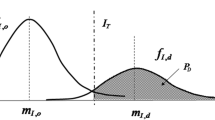Abstract
Vibration-based damage detection methods able to recognize cracks in the early state require accurate frequency evaluation in order to identify small modal changes. Because of higher order, the natural frequencies are rapidly damped, time history provides insufficient information if standard frequency estimations are performed. This paper introduces a method of overlaying multiple spectra achieved by iterative truncation of the original signal. In this way, the spectral bin number becomes much higher and the identification of real natural frequencies is easier. Also, an original damage detection algorithm based on the frequency shift is described that considers the first six bending vibration modes occurred due to damage. These are in direct relation to the modal strain energy stored at the damage location. The effectiveness of the detection method is proved using real structures in some damage scenarios. Thus, it was shown that even if a crack reduces the beam’s transversal cross section by only 6%, it can be clearly detected.








Similar content being viewed by others
References
Abdollahifar RA, Nami MR (2014) Determination of dynamic stress intensity factor in FGM plates by MLPG method. IJST Trans Mech Eng 38(M1):181–194
Afshari M, Inman DJ (2013) Continuous crack modeling in piezoelectrically driven vibrations of an Euler-Bernoulli beam. J Vib Control 19(3):341–355
Arvin H (2014) Frequency response analysis of higher order composite sandwich beams with viscoelastic core. IJST Trans Mech Eng 38(M1):143–155
Azadi M (2011) Free and forced vibration analysis of FG beam considering temperature dependency of material properties. J Mech Sci Technol 25(1):69–80
Böhm M, Tasche M, Seifert B, Mitschke F (2009) Trim-to-coherence Fourier transform, Elsevier, ScienceDirect. J Comput Phys 228:2906–2917
Deraemaeker A, Preumont A, Kullaa J (2006) Modeling and removal of environmental effects for vibration based SHM using spatial filtering and factor analysis. In: Proceedings of IMAC XXIV. St Louis
Ekinovic E (2010) An approximate technique for damage identification in beams using shifts in natural frequencies. In: Proceedings of the 22nd international conference on noise and vibration engineering, paper 0024
Gillich GR, Praisach ZI (2012) Damage-patterns-based method to locate discontinuities in beams. In: Proceedings of SPIE 8695, health monitoring of structural and biological systems, paper 869532
Gillich GR, Praisach ZI (2014) Modal identification and damage detection in beam-like structures using the power spectrum and time-frequency analysis. Signal Process 96:29–44
Gillich GR, Praisach ZI, Abdel Wahab M, Vasile O (2014) Localization of transversal cracks in sandwich beams and evaluation of their severity. Shock Vib 2014:1–10
Gillich GR, Praisach ZI, Iavornic CM (2012) Reliable method to detect and assess damages in beams based on frequency changes. In: Proceedings of the ASME international design engineering technical conferences and computers and information in engineering conference 2012, vol 1, Pts. A and B. pp 129–137
Gustafsson F, Ljung L, Millnert M (2010) Signal processing. Studentlitteratur, Lund
Jacobsen E, Kootsookos P (2007) Fast, accurate frequency estimators. IEEE Signal Process Mag 24:123–125
Khiem NT, Toan LK (2014) A novel method for crack detection in beam-like structures by measurements of natural frequencies. J Sound Vib 333:4084–4103
Minda AA, Gillich N, Mituletu IC, Ntakpe JL, Manescu T, Negru I (2015) Accurate frequency evaluation of vibration signals by multi-windowing analysis. Appl Mech Mater 801:328–332
Nami MR, Janghorban M (2015) Free vibration of functionally graded size dependent nanoplates based on second order shear deformation theory using nonlocal elasticity theory. IJST Trans Mech Eng 39(M1):15–28
Praisach ZI, Gillich GR (2013) Influence of multiple cracks upon the dynamic behaviour of beams. In: Proceedings of the 5th international conference on structural engineering, mechanics and computation. pp 2199–2204
Praisach ZI, Gillich GR, Protocsil C, Muntean F (2013) Evaluation of crack depth in beams for known damage location based on vibration modes analysis. Appl Mech Mater 430:90–94
Richardson MH, Mannan MA (1993) Correlating minute structural faults with changes in modal parameters. In: Proceedings of 11th MAC. pp 893–898
Sinou J-J (2009) A review of damage detection and health monitoring of mechanical systems from changes in the measurement of linear and non-linear vibrations”. In: Mechanical vibrations: measurement, effects and control. pp 643–702
Tufoi M, Gillich GR, Praisach ZI, Iancu V, Furdui H (2014) About the influence of temperature changes on the natural frequencies of clamped-clamped euler-bernoulli beams. Roman J Acoust Vib 11(2):84–87
Acknowledgements
The work has been funded by the Sectoral Operational Programme Human Resources Development 2007–2013 of the Ministry of European Funds through the Financial Agreement POSDRU/159/1.5/S/132395.
Author information
Authors and Affiliations
Corresponding author
Rights and permissions
About this article
Cite this article
Gillich, G.R., Mituletu, I.C., Praisach, Z.I. et al. Method to Enhance the Frequency Readability for Detecting Incipient Structural Damage. Iran J Sci Technol Trans Mech Eng 41, 233–242 (2017). https://doi.org/10.1007/s40997-016-0059-8
Received:
Accepted:
Published:
Issue Date:
DOI: https://doi.org/10.1007/s40997-016-0059-8




